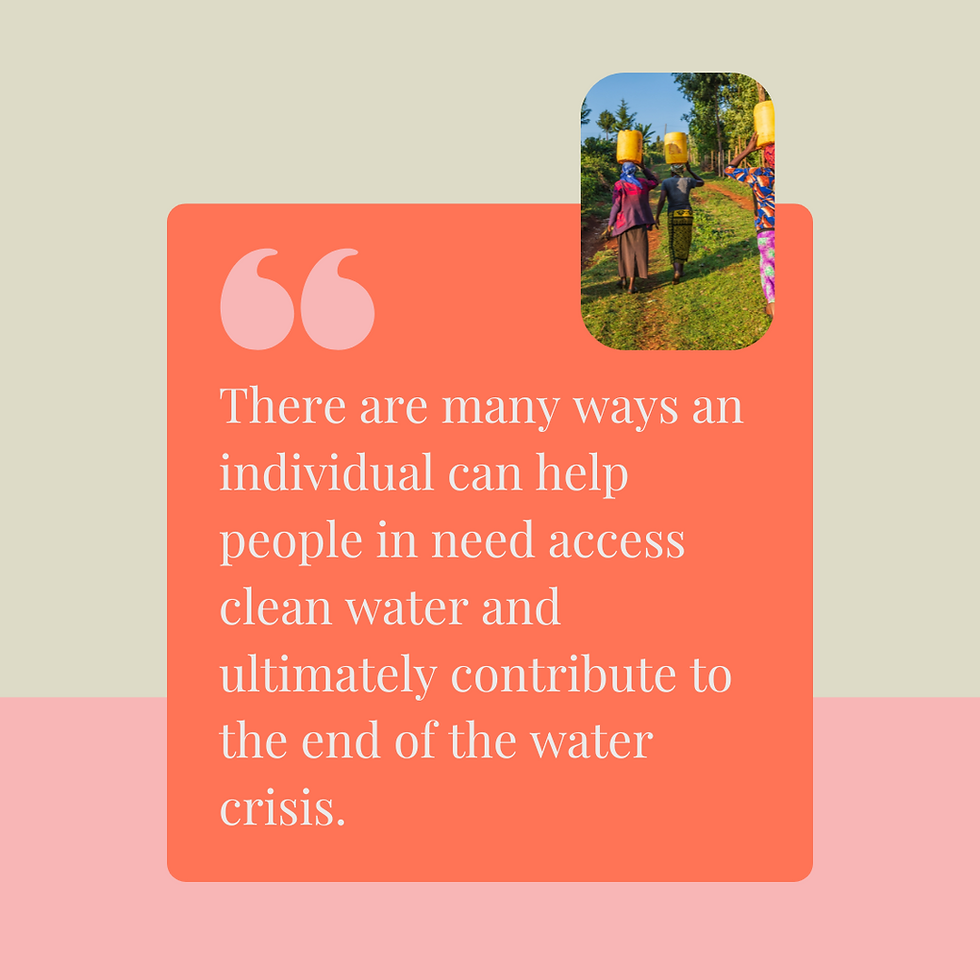By Jonas Wahlstedt
Difficulty finding safe and abundant sources of fresh water has been an issue for thousands of years, but never in human history has it been possible to end the water crisis like it is today. Even with recent advancements in technology and infrastructure across the world, almost 1 in 4 people worldwide, approximately 2.2 billion, lack access to safe water (water.org). Access to safe water is just as important as access to water in general, as unsafe water can cause illness, diseases, and long term negative side effects to people who consistently drink it. Furthermore, four billion people experience severe water scarcity at least one month a year (unicef.org). Being unable to drink fresh and safe water is unimaginable for most people in developed countries, but is unfortunately a daily reality for a large percentage of the world’s populace. It is important that people in all areas are informed and educated about this topic, and whenever possible, attempt to make a difference. This blog post will provide potential options for people that want to help reduce and ultimately end the water crisis. Assistance would help give millions of people a better standard of life and increased opportunity to find success and happiness in their futures.
The global population currently exceeds 8 billion people, and is predicted to increase substantially in the upcoming decades, meaning that the water crisis is expected to worsen unless measures are taken soon (UN.org; Khalil, 2023). This sharp population rise paired with an overuse of water for personal and industrial purposes in many developed nations, reveals that there are serious problems with the way water is used and viewed as a necessity (weforum.org, 2014). Studies have shown that freshwater sources are being polluted and depleted due to climate change and human activity (Denchak, 2023). One way people can help end the water crisis is by reducing their wasting of water, advocating for more stringent pollution guidelines in their area, and supporting officials who prioritize climate change reduction measures. While these measures may not have an immediate effect, if they are widely implemented and enforced, water will become more accessible and of higher quality.
Water is crucial for human life, and some companies have exploited that fact for personal gain for a long period of time (Perkins, 2019; Tsui, 2020). Unfortunately, in recent decades this situation has worsened as large conglomerates such as Nestle have purchased large areas containing fresh water to bottle and then sell (Shimo, 2018; Hakim, 2018). These practices are beneficial to the companies and the people buying water in developed countries, but are devastating to local populations that cannot afford bottled water. People can help end these practices by speaking out against these organizations, and reducing or eliminating their consumption of bottled water whenever possible. If it becomes less financially lucrative to purchase the rights to freshwater in countries across the world, companies will change their focus to other projects and thus drinking water will become more accessible to the local people.
A sustainable and environmentally friendly way to help end the water crisis is through the construction and use of water desalination plants (Padmanathan, 2022). While this technology has existed since the late 19th century, it has been difficult for many countries to properly utilize it due to high initial costs and high energy consumption (Herber, 2024). These costs do vary depending on location and local energy prices, so it would be much more affordable in the Middle East or Africa than Europe or the United States. If ample desalination plants were built in areas that contained low levels of fresh water but were near coastlines, it would have an immediate impact. By petitioning their local and state governments to invest aid money in long term solutions such as desalination plants, people can help end the water crisis before it spirals out of control.

There are many ways an individual can help people in need access clean water and ultimately contribute to the end of the water crisis. While some of the methods discussed will not create an immediate large-scale effect, with time and effort, hundreds of millions could have a dramatic improvement in their quality of life. If you are reading this article and would like to take another step to help, please go to buildawaterproject.org to see the amazing work they are doing to build water wells in the country of Bangladesh.
Denchak, M. (2023). Water Pollution: Everything You Need to Know. [online] NRDC. Available at: https://www.nrdc.org/stories/water-pollution-everything-you-need-know#whatis.
Herber, G. (2024). Price of Desalination: Factors and Solutions for Making Clean Water More Affordable. [online] Medium. Available at: https://medium.com/@desalter/price-of-desalination-factors-and-solutions-for-making-clean-water-more-affordable-1a4957803570
Khalil, H. (2023). A quarter of humanity faces extreme water stress – and it’s poised to get worse, new report finds. [online] CNN. Available at: https://edition.cnn.com/2023/08/16/world/water-stress-scarcity-climate-crisis-scn-intl/index.html#:~:text=A%20quarter%20of%20the%20world
Padmanathan, P. (2022). Can desalination be a sustainable solution to the water crisis? [online] World Economic Forum. Available at: https://www.weforum.org/agenda/2022/06/technology-and-entrepreneurship-can-quench-our-parched-world/.
Perkins, T. (2019). The fight to stop Nestlé from taking America’s water to sell in plastic bottles. [online] The Guardian. Available at: https://www.theguardian.com/environment/2019/oct/29/the-fight-over-water-how-nestle-dries-up-us-creeks-to-sell-water-in-plastic-bottles.
Shimo, A. (2018). While Nestlé extracts millions of litres from their land, residents have no drinking water. [online] The Guardian. Available at: https://www.theguardian.com/global/2018/oct/04/ontario-six-nations-nestle-running-water.
Shireen Hakim (2018). Here’s how Nestle is leaving millions in Pakistan, Nigeria and Flint without clean water - The Muslim Vibe. [online] Themuslimvibe.com. Available at: https://themuslimvibe.com/muslim-current-affairs-news/heres-how-nestle-is-leaving-millions-pakistan-nigeria-and-flint-without-clean-water.
Tsui, J. (2020). Big Corporations Contribute to Water Shortages — How Can They Fix It? -- Environmental Protection. [online] Environmental Protection. Available at:
United Nations (2019). Population. [online] United Nations. Available at: https://www.un.org/en/global-issues/population#:~:text=The%20world.
World Economic Forum. (2014). The damage caused by water overuse. [online] Available at: https://www.weforum.org/agenda/2014/12/the-damage-caused-by-water-overuse/.
.png)
Comments